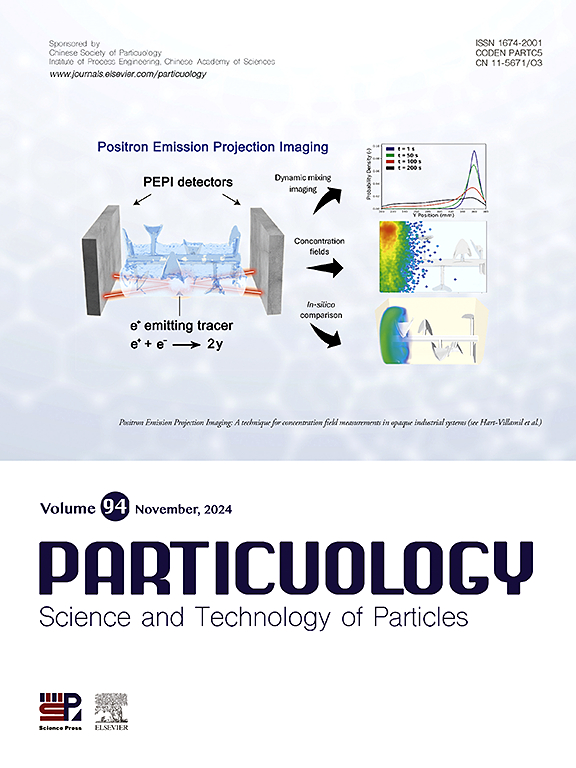流化床原子层沉积法制备TiO2薄膜的生长特性
IF 4.3
2区 材料科学
Q2 ENGINEERING, CHEMICAL
引用次数: 0
摘要
TiO2是一种超宽带隙半导体,具有优异的物理性能,在光催化和光电催化方面有着广阔的应用前景。流化床原子层沉积(FBALD)是沉积TiO2薄膜的有效方法,具有精确的厚度控制。本研究全面研究了FBALD法制备SiO2颗粒上TiO2薄膜的生长特性和性能,重点研究了循环次数、温度、前驱体浓度、脉冲时间、吹扫时间和前驱体组分对TiO2薄膜生长的影响。TEM图像表明,在120°C和180°C的温度下,TiO2形成了连续均匀的薄膜,而在240°C和300°C的温度下,TiO2形成了分散的纳米级孤岛。通过增加前驱体供给或减少N2吹扫时间,膜的生长速率显著提高。增加前驱体脉冲时间对膜的生长有较强的影响,而减少N2吹扫时间会导致膜厚度的生长更加不均匀。以TiCl4和TTIP为前驱体合成的核壳结构SiO2@TiO2光催化剂均表现出良好的光催化降解性能,在300 W氙灯照射60 min下,对盐酸四环素(TC)的降解效率分别达到95%和90%。该性能优于相同质量分数下溶液浸渍法制备的催化剂。本文章由计算机程序翻译,如有差异,请以英文原文为准。

Growth characteristics of TiO2 films synthesized by fluidized bed atomic layer deposition
TiO2 is an ultra-wide bandgap semiconductor with excellent physical properties and promising applications in photocatalysis and photo-electrocatalysis. Fluidized bed atomic layer deposition (FBALD) is an effective method for depositing TiO2 films, offering precise thickness control. This study presents a comprehensive investigation into the growth characteristics and properties of TiO2 films on SiO2 particles prepared via FBALD, with a focus on the impact of cycle number, temperature, precursor concentration, pulse time, purge time and precursor component. The TEM images indicate that continuous and uniform TiO2 films are formed at 120 °C and 180 °C, whereas dispersed nanoscale TiO2 islands are observed at 240 °C and 300 °C. By increasing precursor supply or reducing N2 purge time, the film growth rate significantly increases. Additionally, increasing the precursor pulse time has a stronger effect on film growth, while decreasing the N2 purge time leads to more uneven film thickness growth. The core-shell structured SiO2@TiO2 photocatalysts synthesized using TiCl4 and TTIP as precursors both exhibit good photocatalytic degradation performance that, under 300 W xenon lamp irradiation for 60 min, the degradation efficiency of tetracycline hydrochloride (TC) reaches 95 % and 90 %, respectively. This performance surpasses that of catalysts prepared by solution impregnation method under the same mass fraction.
求助全文
通过发布文献求助,成功后即可免费获取论文全文。
去求助
来源期刊

Particuology
工程技术-材料科学:综合
CiteScore
6.70
自引率
2.90%
发文量
1730
审稿时长
32 days
期刊介绍:
The word ‘particuology’ was coined to parallel the discipline for the science and technology of particles.
Particuology is an interdisciplinary journal that publishes frontier research articles and critical reviews on the discovery, formulation and engineering of particulate materials, processes and systems. It especially welcomes contributions utilising advanced theoretical, modelling and measurement methods to enable the discovery and creation of new particulate materials, and the manufacturing of functional particulate-based products, such as sensors.
Papers are handled by Thematic Editors who oversee contributions from specific subject fields. These fields are classified into: Particle Synthesis and Modification; Particle Characterization and Measurement; Granular Systems and Bulk Solids Technology; Fluidization and Particle-Fluid Systems; Aerosols; and Applications of Particle Technology.
Key topics concerning the creation and processing of particulates include:
-Modelling and simulation of particle formation, collective behaviour of particles and systems for particle production over a broad spectrum of length scales
-Mining of experimental data for particle synthesis and surface properties to facilitate the creation of new materials and processes
-Particle design and preparation including controlled response and sensing functionalities in formation, delivery systems and biological systems, etc.
-Experimental and computational methods for visualization and analysis of particulate system.
These topics are broadly relevant to the production of materials, pharmaceuticals and food, and to the conversion of energy resources to fuels and protection of the environment.
 求助内容:
求助内容: 应助结果提醒方式:
应助结果提醒方式:


